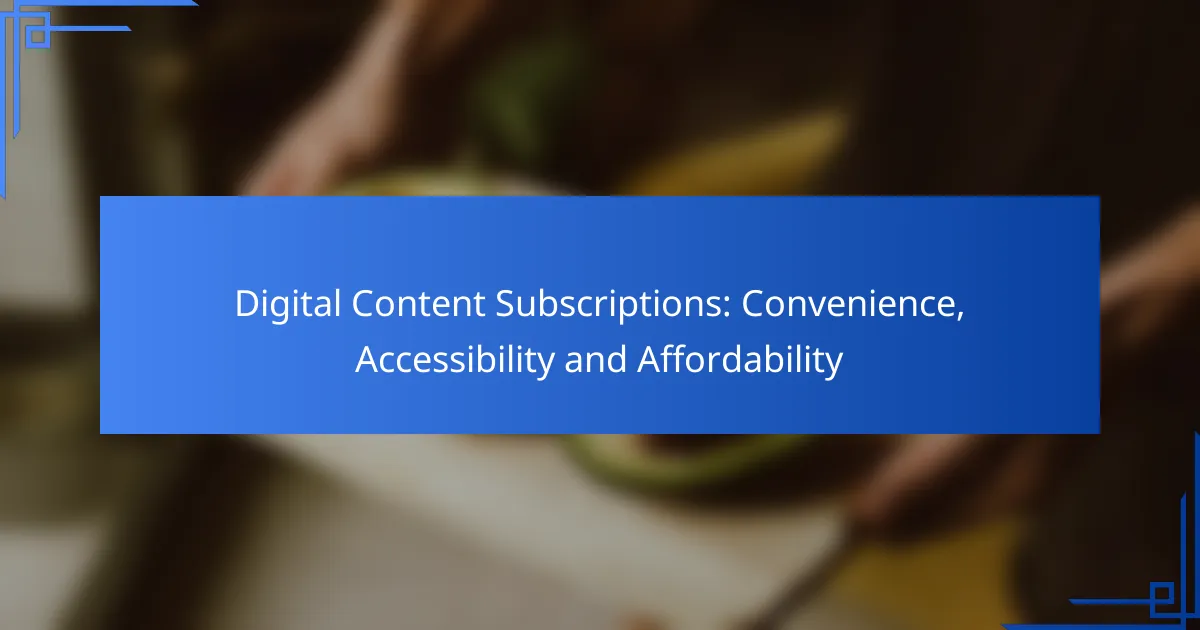Digital content subscriptions have revolutionized the way consumers access media, offering unparalleled convenience and immediate availability of movies, music, and books without the need for physical storage. With widespread internet connectivity and competitive pricing, these services are easily accessible, catering to diverse preferences and budgets. Additionally, they provide an affordable alternative to traditional purchasing methods, allowing users to enjoy a vast array of content at a fraction of the cost.

How do digital content subscriptions enhance convenience in the US?
Digital content subscriptions significantly enhance convenience in the US by providing users with immediate access to a wide array of media without the need for physical storage or traditional purchasing methods. This model allows consumers to enjoy their favorite movies, music, and books anytime and anywhere, streamlining the way they consume content.
Instant access to content
With digital content subscriptions, users can instantly access a vast library of media, eliminating the wait associated with physical purchases or rentals. For example, platforms like Netflix and Spotify allow subscribers to start watching or listening within moments of signing up. This immediacy caters to the growing demand for on-the-go entertainment.
Moreover, many services offer downloadable content, enabling offline access. This feature is particularly useful for users who travel or have limited internet connectivity, ensuring that entertainment is always available when needed.
Flexible viewing options
Digital subscriptions provide flexible viewing options that cater to individual schedules and preferences. Users can choose to binge-watch entire seasons of shows or watch episodes at their own pace, fitting entertainment into their busy lives. This flexibility is a key factor in the appeal of subscription services.
Additionally, many platforms allow users to create personalized playlists or watchlists, making it easy to curate content that aligns with their interests. This customization enhances the overall viewing experience and encourages continued engagement with the service.
Multi-device compatibility
Most digital content subscriptions are designed to be compatible across multiple devices, including smartphones, tablets, laptops, and smart TVs. This compatibility ensures that users can enjoy their favorite content wherever they are, whether at home or on the move. For instance, a user can start watching a movie on their TV and continue on their phone without interruption.
It is essential for subscribers to check device compatibility before signing up for a service. Some platforms may have restrictions on the number of devices that can stream simultaneously, which could affect family usage. Understanding these limitations can help users choose the right subscription for their needs.

What makes digital content subscriptions accessible in urban areas?
Digital content subscriptions are accessible in urban areas due to a combination of widespread internet connectivity, diverse platforms, and competitive pricing. These factors enable residents to easily access a variety of content options that suit their preferences and budgets.
Wide range of platforms
Urban areas typically host a multitude of digital content platforms, ranging from streaming services like Netflix and Spotify to e-book subscriptions such as Kindle Unlimited. This variety allows users to choose services that align with their interests, whether in entertainment, education, or news.
Many platforms offer unique features, such as offline access or personalized recommendations, enhancing the user experience. This competition among providers often leads to better quality content and innovative offerings.
Affordable pricing models
Pricing models for digital content subscriptions in urban areas are often designed to be budget-friendly, with many services offering monthly fees that can range from a few dollars to around twenty. This affordability makes it easier for a broader audience to subscribe without significant financial strain.
Some platforms also provide family plans or bundled subscriptions, allowing multiple users to share costs. This flexibility in pricing encourages more people to explore various content options without committing to high upfront costs.
Availability of free trials
Many digital content providers in urban areas offer free trials, enabling potential subscribers to experience the service before making a financial commitment. These trials typically last from a week to a month, allowing users to evaluate the content and features available.
Taking advantage of free trials can help users make informed decisions about which subscriptions best meet their needs. However, it’s essential to remember to cancel before the trial period ends to avoid unexpected charges.

How do digital content subscriptions offer affordability?
Digital content subscriptions provide affordability by allowing users to access a wide range of media at a lower cost compared to purchasing individual items. This model often includes various pricing tiers and options that cater to different budgets, making it easier for consumers to find a suitable plan.
Cost-effective alternatives to traditional media
Digital content subscriptions serve as cost-effective alternatives to traditional media such as newspapers, magazines, and physical books. Instead of paying for each item separately, subscribers can access an extensive library of content for a monthly or annual fee, often saving significant amounts over time.
For example, a monthly subscription to a streaming service can cost less than a single movie ticket, allowing users to enjoy unlimited viewing options. This shift not only reduces costs but also enhances convenience, as users can access content anytime and anywhere.
Bundled subscription packages
Many digital content providers offer bundled subscription packages that combine multiple services at a discounted rate. These bundles often include various types of media, such as music, movies, and e-books, providing a comprehensive entertainment solution for one price.
For instance, a bundle may include a streaming service, an audiobook platform, and a digital magazine subscription for a single monthly fee, which is typically lower than subscribing to each service separately. This approach maximizes value and simplifies billing for consumers.
Discounts for long-term commitments
Subscribing for longer periods often comes with discounts that enhance affordability. Many platforms offer reduced rates for annual subscriptions compared to monthly payments, encouraging users to commit for a longer duration.
For example, a service might charge $10 per month or offer an annual plan for $100, effectively giving two months free. This strategy not only benefits users financially but also fosters loyalty to the service, as users are less likely to cancel their subscriptions when they have made a long-term commitment.

What criteria should you consider when choosing a digital content subscription?
When selecting a digital content subscription, consider factors like content library diversity, user interface and experience, and customer support options. These criteria will help ensure that the service meets your needs and provides a satisfactory experience.
Content library diversity
A diverse content library is crucial for keeping your interest and ensuring you have access to various genres and formats. Look for subscriptions that offer a wide range of movies, TV shows, music, e-books, and podcasts. Services with partnerships or exclusive content can enhance the variety available to you.
Evaluate the frequency of new content additions as well. A subscription that regularly updates its library can keep your viewing or listening experience fresh and engaging. Consider platforms that cater to your specific interests, whether that’s niche genres or popular mainstream titles.
User interface and experience
The user interface (UI) and overall experience play a significant role in how enjoyable a digital content subscription is. A clean, intuitive layout makes it easier to navigate and find content quickly. Look for features like personalized recommendations, search functionality, and easy access to your watchlist or library.
Consider the compatibility of the service with your devices as well. A subscription that works seamlessly across smartphones, tablets, smart TVs, and computers enhances accessibility and convenience. Read user reviews to gauge the overall satisfaction with the platform’s usability.
Customer support options
Reliable customer support is essential for resolving issues that may arise with your subscription. Check if the service offers multiple support channels, such as live chat, email, or phone support. Quick response times can significantly enhance your overall experience.
Additionally, look for resources like FAQs, community forums, or troubleshooting guides. These can provide immediate assistance for common issues, allowing you to resolve problems without needing to contact support directly.

How do user reviews impact digital content subscription choices?
User reviews significantly influence digital content subscription decisions by providing insights into the experiences of current users. Potential subscribers often rely on these reviews to gauge content quality, service reliability, and how different platforms compare to one another.
Insights on content quality
User reviews often highlight the strengths and weaknesses of the content offered by a subscription service. For instance, a platform with a vast library of high-quality films and shows may receive positive feedback, while one with limited or outdated content might face criticism. This feedback helps potential subscribers assess whether the content aligns with their interests.
Moreover, reviews can indicate the frequency of new content releases. A service that regularly updates its offerings is likely to attract more subscribers, as users seek fresh material to enjoy.
Feedback on service reliability
User reviews frequently address the reliability of a digital content subscription service, including streaming quality and uptime. Services that consistently deliver smooth streaming experiences with minimal buffering tend to receive favorable reviews. In contrast, platforms with frequent outages or technical issues may deter potential subscribers.
Additionally, reviews often discuss customer support experiences. A service that provides prompt and effective assistance can enhance user satisfaction, while poor customer service can lead to negative perceptions and lost subscriptions.
Comparative analysis of platforms
User reviews facilitate comparative analysis among different digital content subscription platforms. By reading reviews, potential subscribers can identify which services offer the best value for their money, considering factors like content variety, pricing, and user experience.
For example, a user might find that one platform offers a lower monthly fee but has limited content, while another service may charge more but provide a richer library and better streaming quality. This information allows users to make informed choices based on their preferences and budget.

What emerging trends are shaping digital content subscriptions?
Emerging trends in digital content subscriptions focus on personalization, bundling services, and the rise of ad-supported models. These trends enhance user experience and accessibility while providing cost-effective options for consumers.
Personalization and User Experience
Personalization is becoming a key factor in digital content subscriptions, as platforms leverage data analytics to tailor offerings to individual preferences. Users can expect curated content recommendations based on their viewing habits, which enhances engagement and satisfaction.
For example, streaming services like Netflix and Spotify utilize algorithms to suggest shows and music that align with user tastes. This trend not only improves user experience but also increases retention rates for subscription services.
Bundling Services
Bundling services is another trend shaping digital content subscriptions, where companies combine multiple offerings into a single package. This approach often provides better value for consumers, allowing them to access various types of content at a lower overall cost.
For instance, platforms like Amazon Prime offer video streaming, music, and shopping benefits in one subscription. This bundling strategy can attract a wider audience and encourage users to engage with multiple services.
Ad-Supported Models
The rise of ad-supported models is transforming how consumers access digital content. Many platforms are now offering free or lower-cost subscriptions that include advertisements, making content more accessible to a broader audience.
Services like Hulu and Peacock provide ad-supported tiers, allowing users to enjoy content without a hefty subscription fee. This trend reflects a shift in consumer preferences, as many are willing to watch ads in exchange for free or reduced-cost access to their favorite shows and movies.
